
Wine chemistry is fascinating and extremely complex. I know very little about it (although a little more than a few weeks ago), but am going to use Stewart's physicochemical approach to acid-base physiology to try and predict pH and other changes when certain things are added to wine. Read on... but also consult our applet and the associated documentation!
As with many other fun drinks (coffee, for example), there are literally hundreds of compounds that go to make up a good glass (cup, goblet, or whatever)! We are interested in but a few, as we here consider mainly the acid-base chemistry of wine, and pay scant attention to the trace amounts of volatile substances that give each bottle most of its special character --- wine tasting depends largely on the sense of smell, after all!
The components which attract our attention are:
The major idea behind wine-making is to convert the sugar present in the grapes into ethyl alcohol, until the concentration rises enough to kill the yeast and inhibit further alcohol formation, or the winemaker steps in and adds something to bump off the yeast. During this process of fermentation, many other things happen.
The principal substances we are concerned with are water, and organic acids. There are about six acids that feature prominently in wine, although only two (malic and tartaric acid) appear to be of prime importance in good wine. Here are the acids:
We will later on consider each of these in detail, but here's the executive summary. Tartaric acid is pretty well unique to grapes; the others are commonly found in a variety of fruits. Tartaric and succinic acid are pretty stable acids, citric acid (which gives a fruity citrus tang to some white wines) is a potential problem as it can sometimes be turned into acetic acid, which as we all know, is vinegar. (The major cause of a batch of wine turning to vinegar is however exposing the wine to air, which allows the bacterium Acetobacter aceti to turn ethyl alcohol in the wine into acetic acid, using the enzyme alcohol dehydrogenase).
Malic acid is a fairly strong-ish acid, and if the pH of a wine is a little on the low side, the smart winemaker may introduce appropriate micro-organisms that convert this acid into the milder lactic acid --- so-called "Malo-lactic" fermentation (ML fermentation). The pH should then rise. We wish to quantify such changes, and the other changes that will occur when wine-makers add various substances to wine to alter its properties, notably pH and `titratable acidity'.
Here we consider ML fermentation in more detail. Initially, you may wish to skip this section. Note that some micro-organisms form only lactic acid (`homofermentary bacteria'), while others form a variety of products, sometimes including acetic acid, which is undesirable. Heterofermentary bacteria include Leuconostoc oenos (recently renamed Oenococcus oeni ), other Leuconostoc species, and some Lactobacilli. O. oeni is an important organism in many ML cultures, despite its heterofermentation. Homofermentary bacteria include Pediococcus cerevisiae , Pediococcus damnosus , Lactobacillus plantarum and L. casei .
MLF involves the conversion of malic acid to lactic acid and carbon dioxide. Note that some bacteria will also metabolise sugars, and some of the less desirable ones will even break down tartaric acid and glycerol. It is said that titratable acidity is lowered by 1.5--4.6g/l, and pH increases 0.1 to 0.3. Acetic acid may increase by 0.05 to 0.2g/l, tending to be greater with reproduction of ML bacteria in wine than with actual ML fermentation. This latter observation prompts some to inoculate with large numbers of such bacteria if ML fermentation is desired. ML fermentation is unlikely to proceed well at a pH of under 3.2 (unless special strains are used), and is inhibited by SO 2 in concentrations over 0.8mg/l molecular SO 2 . Temperature is also important (should be above 15 o C, and ideally above 18 o C for ML fermentation). Addition of lysozyme turns off ML fermentation by destroying the relevant bacteria.
As an aside, some desirable ML bacteria actually increase esters in wine, increasing desirable aromas. Other compounds increased are ethyl lactate, and diacetyl (from citric acid), which may be desirable in whites and is generally frowned upon in reds. ML bacteria ruin wine containing sorbate by forming ethoxyesadiene, which has an undesirable geranium smell. ML fermentation is commonly used in reds, if only to prevent it occurring later, and harming the wine! It's not usually done until most of the sugar has been fermented away.
For a variety of reasons, the following properties of wine are most desirable:
Some explanation is in order. First, the pH. The reason for the pH range is that at higher pH, nasty bacteria will almost certainly get in and destroy the wine (and it won't taste as good), and at lower pH the wine will be rather acid. (The pH of vinegar is about 3.0 or less).
The TA is something else. Rather empirically, wine makers and wine tasters have found that pH is not enough. The determinants of acidity seem themselves to play a role in taste. It is said that blind tasting of the various acids is quite an educational experience to the average wine taster, although of course to be fair, one should buffer such solutions in order to make the pH the same in all cases! What we are sure is that you can have too much or too little of these organic acids. The way we measure the total quantity of organic acids is the titratable acidity.
TA is determined by dripping a base such as sodium hydroxide into the wine and watching the pH. Originally this was done using a dye that changed colour at a certain pH, but now we often use an expensive and accurate pH meter. We look at the amount of base we've added to achieve a given pH, and this is the TA. (Unfortunately, some titrate to a pH of 7.0, and others to a pH of 8.2, the latter mainly because colour change in the dye phenolphthalein was often used as an end-point, and this is the pH at which this dye suddenly goes purple).
Here comes the tricky bit. The TA is now expressed in grams of tartaric acid , or an equivalent percentage. So, a titratable acidity of say, 0.65% means that if we added 6.5g of tartaric acid to 993.5g of water, we would then require the same amount of base as we just used, to titrate this tartaric acid solution to the same pH! (The French are more honest and less complicated, and tend to express TA in terms of sulphuric acid, which is necessarily a far smaller quantity, as H2SO4 is a strong acid, and not weak like tartaric acid).
You can work out that if you use 15ml of wine and 0.2N NaOH, then the number of millilitres of NaOH divided by ten is the TA in terms of tartaric acid! For example, if the TA is 0.65%, we will need 6.5ml of 0.2N NaOH!
We can do no better than quote John Wiedenheft in his statement of the problem:
Here's what got me researching this issue of acidity in wines: Two of my buddies & I started making wine from kits. We started a Pinot Noir this winter (our first batch) following the instructions. At the same time we started reading. Consequently, we started purchasing some analysis tools and trying to learn how to use them. First we got a hydrometer, then a titratable acidity measurement kit, and finally a pH meter. Concurrently with the studying up on winemaking, we were starting other kits. As our understanding and ability to accurately measure specific gravity, titratable acidity (TA), and pH grew, we started taking these measurements. Unfortunately, by the time we realized that our first batch had a TA of 10.0 g/l (tartaric), and a pH of 3.3, it was too late for a malo- lactic fermentation (Malo-lactic fermentation converts the malic acid into lactic acid, resulting in a lower TA, and depending on the buffer capacity of the wine, may or may not have an impact on the pH.) We already had added the potassium metabisulfite and potassium sorbate that the instructions called for prior to bottling. (These two chemicals effectively "sterilize" the wine - they make the invironment that the malo-lactic bacteria require inhospitable for them.) We are planning to try adding some potassium bicarbonate to try to bring the acidity down some. But how much? The above problem and all of this reading has lead me to understand that the pH / TA issue is far from simple. The various acids involved dissociate at different rates from each other, and each acid also dissociates at different rates depending on the pH of the solution that you are adding them to. So if you have a juice with a high pH and a low TA, how much of each acid do you need to add in order to achieve your final goals? Achieving the correct pH would seem to be my number 1 priority, but if adding enough tartaric acid to get the right pH causes too high of a TA, how about some tartaric and some malic? And maybe throw in a malo-lactic fermentation (MLF) later to bring the TA down again, if necessary? But how much of each? Very complicated. As I mentioned in my first email, I had been scouring the Internet looking for an acid calculator. What I thought I wanted was a calculator that I could plug in the pH and the TA of the juice, and plug in the desired pH and TA of the finished wine, and the calculator would figure out the various dissociation rates, and provide me with a graph with two curves on it, one of tartaric and one of malic, with the vertical axis representing grams per liter additions, and the horizontal axis representing % malic of the total of both additions. Any point along the horizontal axis would be a solution for the problem of how much of each acid to add, and I could just pick the one I wanted.
There's a long list of things that people (even respectable winemakers) have added to wine to alter its properties. Disreputable chaps have added things like ethylene glycol, and we won't mention such practices further. The following might be added:
Oh, and, of course, yeast!
We have already discussed the Stewart approach to acid-base balance in human plasma. In the case of wine, we also have a set of equations that need to be solved, to give us a `complete' picture of the relationship between independent variables (SID and concentration of the various organic acids, and to a tiny degree PCO2 ), and all of the dependent variables, the most important of which is pH.
Prior to examining the equations governing pH in wine, we'll take a quick tour of the major acids in wine. As an aside, if you have the CHIME plugin installed, you can click on the pictures in the next section, and view them in three dimensions. Before we do this, note that there are two considerations of some interest, ion activity and alcohol. We will however relegate both of these to an appendix (Appendix A), as our initial approach will be extremely simplistic!
| TABLE 1: Characteristics of the acids | ||||
| Acid | Formula | Molecular Wt | pK a | Our name |
| tartaric (+)-(2R,3R) | C 4 H 6 O 6 | 150.09 | 2.98 (3.02)* 4.54 * |
K 0 tar K 1 tar |
| malic | C 4 H 6 O 5 | 134.09 | 3.40 (* too) 5.05 * |
K 0 mal K 1 mal |
| succinic | C 4 H 6 O 4 | 118.09 | 4.16 (4.19)* 5.57* (5.6 +) |
K 0 suc K 1 suc |
| lactic | C 3 H 6 O 3 | 90.08 | 3.86 (* too) | K 0 lac |
| citric | C 6 H 8 O 7 | 192.12 | 3.13 (3.06)* 4.76 (4.74)* 5.40 (* too) |
K 0 cit K 1 cit K 2 cit |
| acetic (ethanoic) | C 2 H 4 O 2 | 60.06 | 4.75 (4.76)* | K 0 ace |
| *Petrik, +Kerber | ||||
Tartaric acid is characteristic of wine, and usually present in concentrations of about 1--5g/kg, about half to two thirds of the organic acids in wine. Tartaric acid is pretty resistant to degradation by most bacteria, and is the main reason why good wine lasts so long. As wine ages, calcium and potassium in the wine tends to form insoluble crystals with tartaric acid; this precipitation can be speeded by cooling the wine. (Removal of "cream of tartar" --- potassium bitartrate by "cold stabilization").
Of interest is that tartaric acid has two centres of rotation. The form in wine is (+)-(2R,3R) tartaric acid. A long time ago, a rare form of tartaric acid was identified, with no optical rotation. It was called racemic acid , and later found to be a mixture of 50% (+)-(2R,3R) and (-)-(2S,3S) tartaric acid. From then on, mixtures of two enantiomers were called racemic !
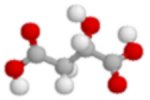
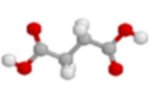
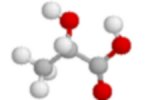

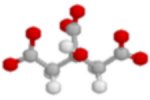
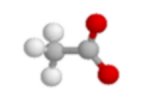
In our calculations, we will ignore both the effects of alcohol, and the important consideration that ion activity and amount of substance present are not the same thing. Here we look briefly at these concepts.
Unfortunately, the effect produced by an ion in solution is not necessarily identical to its concentration in solution. This is because charged ions interact in solution. What they usually do is shield one another from interacting with other charged ions, something like people at a crowded party preventing someone from getting across the room to meet a friend.
Note that thermodynamic activities of aqueous solutes are usually molal, i.e. expressed as mol/kilogram , multiplied by a molal activity coefficient.
In the case (heh) of wine, we may have a problem, and should probably talk in terms of activity for all ions present. Use of activities is tricky, if we only know amounts in g/l (or g/kg). The standard (IUPAC) approach is to use the molal activity coefficient of the ion. This may in some circumstances be given by the Debye Hückel law, which calculates gamma, the mean activity coefficient for a pair of ions:
ln (gamma)± = - |z +.z -|.alpha.I ½ --------------- (1 + a.beta.I ½) alpha = (2.pi.N A .rho)½( e 2 / (4.pi.epsilon.k.T))3/2 s I = 1/2 Sigma z i 2 (m i /m o ) i=1
z = the valence of the ion m = the molarity of the ion s = the number of charged species m o = see below! rho = the density of the solution epsilon = the permittivity of the solution a = the diameter of the ion (assumption: uniform hard charged sphere) T = temperature (Kelvin)
Other constants in the above are 'e', the charge on an electron, 'k' which is Boltzmann's constant, and Avogadro's constant N A . I, the ionic strength, is usually considered to be unitless (although conventions vary)! (In other words, all molar concentrations are divided by 1M, the m o in the above equation for ionic strength). beta is an adjustable (!), empiric (!!) dimensionless constant!
Note that the equation is for a pair of ions! You cannot use DH to calculate the activity coefficient of a single ion! The above equation fails at molar concentrations of ions above about 0.25 mol/l.
In very dilute solutions (under 1mmol/kg) the above is simplified to the limiting Debye-Hückel law:
ln (gamma) = - |z +.z -|.alpha.I ½
In water at room temperature, the value for alpha is about 1.171 kg ½mol -½
The Davies equation assumes a value for a of 3.05E-10 and an aqueous solution at room temperature, and works well up to ionic strengths of 0.5m:
log (gamma)± = - |z +.z -| ( I ½ - 0.30 I ) ------ 1 + I ½
Note that things become even more confusing where there are several ions, especially when the sizes of the ions differ. The traditional Debye-Huckel model may not work well in such circumstances. The formulation for a single ion is often stated along the lines of:
log (gamma)B = - z B 2 alpha.I ½ ----------- 1 + a.beta.I ½
.. but this may not be too kosher!
If we are to include activity coefficients in our calculations, it's probably reasonable to use the Pitzer approach. Calculations involved are non-trivial, and calculating activity coefficients for the various acids may be particularly problematic.
Although it obviously contributes massively to enjoyment of the beverage by most, the major effects of alcohol on the ions would superficially appear to be small. There are however several potential effects:
Note the difference between molar and molal concentrations of a substance. Molal is per kilogram of solvent , molar, per litre. If we have a litre of a solution of 90% water, 10% alcohol by volume , then we have 900ml ~= 897g of water (at 25 o C), and 100ml ~= 79g of alcohol. We only have ~976 grams of solution, even though it's a litre! Add 6 g/l of tartaric acid and we have 6.15 grams per kilogram !
The thermodynamic activity of water is defined as the product of the mole fraction of water multiplied by its activity coefficient. Note that this is quite different from the thermodynamic activities of aqueous solutes, which are usually described in terms of molality, and not mole fractions. (The activity coefficients would be different for mole fractions).
| Date of First Publication: 2003/11/18 | Date of Last Update: 2006/10/24 | Web page author: Click here |